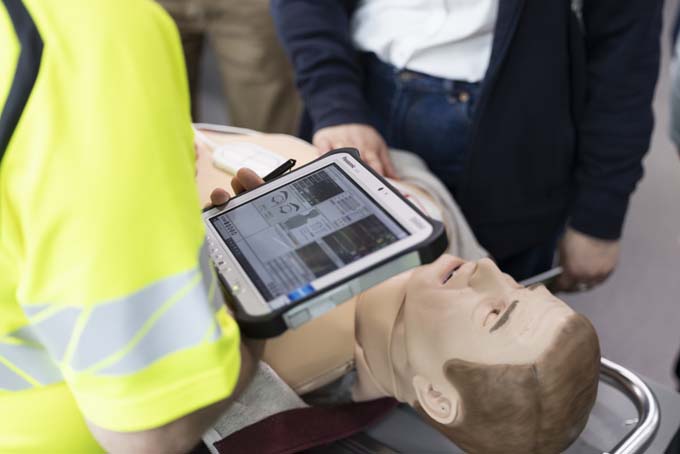The First Aider Symposium was also a complete success in 2024
The 2024 First Aider Symposium focused on the topic of "Women and Men". The speakers conveyed the many differences between women and men in first aid in a humorous and well-founded way. Meanwhile, the First Aider Symposium took place for the last time in the auditorium of the KKL Luzern - next year it will move to the Luzernersaal of the KKL Luzern. The program is already fixed.

As much as we strive to become socially, politically, culturally and economically equal, the anatomy of women and men remains different. And this has an impact on possible medical emergencies and the appropriate first aid. Where there are differences, understanding is needed. It is precisely this understanding that the First Aider Symposium 2024 promoted.
Paramedic and nurse anesthetist Willem van Waasbergen took the participants on a brief excursion into anatomy. He then focused fully on the women: from the menstrual cycle to pregnancies, miscarriages and ectopic pregnancies to cystitis or pre-eclampsia. He underlined the theory with his personal experiences in everyday working life. He also dispelled the question of whether pregnant women should actually be left lying on their left side: better left than right, but better right than on your back.
After a man focused on the women, a woman took on the men. Dr. Doris Mannhard, a specialist in urology FMH from the Uroclinic Uster, talked about all kinds of male emergencies, including inguinal hernias, epididymitis, testicular torsion and urinary retention. She also talked about cases she has encountered in her day-to-day work - and often elicited a noticeable groan from the male participants.
Religious and cultural differences
There are also differences in people's cultural and religious backgrounds. However, these are often not as easy to learn as anatomical peculiarities. Some patients do not want to be resuscitated, others do not want foreign blood, others should not be touched and others should not be left alone in the room. And: it can be extremely difficult to reconcile these differences with your own values and learned procedures.
Stephan Schärli devoted his presentation to this topic. He drew on a wealth of experience: he is a paramedic, head of an interdisciplinary emergency ward at Luks Wolhusen and president of a Spitex. And he gave the participants one thing in particular: It's all about communication - verbal and non-verbal communication.
Panel discussion: The full range of challenges
However, the topic of "men and women" presents many other stumbling blocks in first aid. For example, setting boundaries, legal protection and psychological self-protection for first aiders.
Such questions were addressed in the concluding panel discussion. The speakers were joined by two SVBS board members: Bruno Ducceschi and Katia Güntert shared many stories and examples from their wealth of experience.
The First Aider Symposium 2025 is moving
After four successful events in the auditorium, the next First Aiders Symposium will move to the Lucerne Hall at the KKL Luzern on November 8, 2025 - making it even more professional, even more enjoyable and even more impressive.
The program has already been set. Entitled "First responders - with one foot in prison already?", it addresses various topics with legal relevance:
- The right behavior at the scene of an accident: what do the police and public prosecutor's office not like to see and when can you still get away with it? Michael Muther, head of the Security Police South, goes into this in more detail.
- Dealing with the media: what do you do if you are photographed without being asked, and what are you allowed to say if a journalist asks questions? Media professional Kay Schubert answers these questions.
- Dispensing medication: what may, should or can first aiders dispense? This question repeatedly triggers ignorance, but also a lack of understanding. Rudolf Hauri, cantonal physician in the canton of Zug, will address this topic.
- Marcel Ruf (Lenzburg Prison) explains how first aid is organized in a prison, what to prepare for and how to proceed if the emergency services have to enter and leave the prison.
From beginners to professionals, in German and French
The First Aider Symposium is aimed at all first aiders, whether beginners, advanced or professionals, whether Samaritans, company paramedics, private individuals or emergency services. Thanks to the simultaneous translation of all presentations, first aiders from German-speaking and French-speaking Switzerland are addressed.
The high-caliber speakers devote around an hour to their topics - with plenty of time and space for questions from participants.
Of course, the supporting program is also important: in 2025, even more exhibitors will present their products, courses and services in the foyer and the breaks offer both sufficient time and the right atmosphere to exchange ideas and network.
And: the SGAS has confirmed 2 training points for participation in the First Aider Symposium 2025, the IVR will credit 3.5 hours towards the IVR certificate.
Source: www.ersthelfersymposium.ch









